Attached files
| file | filename |
|---|---|
| 8-K - FORM 8-K - WELLS FARGO & COMPANY/MN | f59629e8vk.htm |
| EX-99.1 - EX-99.1 - WELLS FARGO & COMPANY/MN | f59629exv99w1.htm |
Exhibit 99.2

| 2Q11 Quarterly Supplement July 19, 2011 (c) 2011 Wells Fargo Bank, N.A. All rights reserved. |
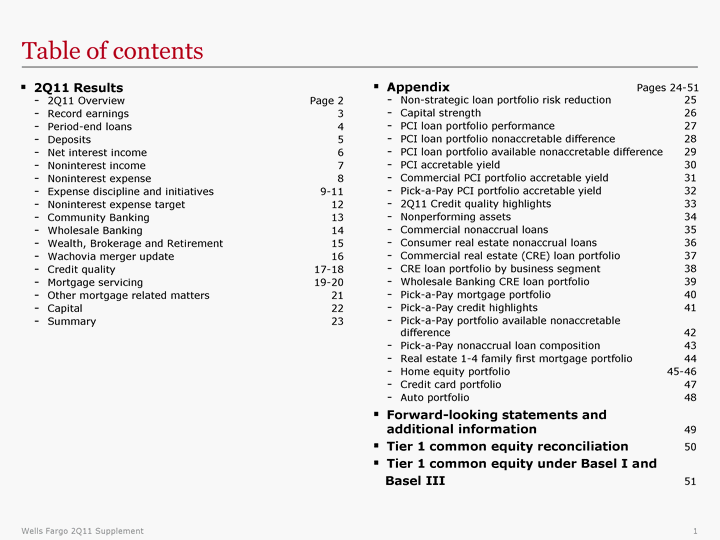
| Appendix Pages 24-51 Non-strategic loan portfolio risk reduction 25 Capital strength 26 PCI loan portfolio performance 27 PCI loan portfolio nonaccretable difference 28 PCI loan portfolio available nonaccretable difference 29 PCI accretable yield 30 Commercial PCI portfolio accretable yield 31 Pick-a-Pay PCI portfolio accretable yield 32 2Q11 Credit quality highlights 33 Nonperforming assets 34 Commercial nonaccrual loans 35 Consumer real estate nonaccrual loans 36 Commercial real estate (CRE) loan portfolio 37 CRE loan portfolio by business segment 38 Wholesale Banking CRE loan portfolio 39 Pick-a-Pay mortgage portfolio 40 Pick-a-Pay credit highlights 41 Pick-a-Pay portfolio available nonaccretable difference 42 Pick-a-Pay nonaccrual loan composition 43 Real estate 1-4 family first mortgage portfolio 44 Home equity portfolio 45-46 Credit card portfolio 47 Auto portfolio 48 Forward-looking statements and additional information 49 Tier 1 common equity reconciliation 50 Tier 1 common equity under Basel I and Basel III 51 Table of contents 2Q11 Results 2Q11 Overview Page 2 Record earnings 3 Period-end loans 4 Deposits 5 Net interest income 6 Noninterest income 7 Noninterest expense 8 Expense discipline and initiatives 9-11 Noninterest expense target 12 Community Banking 13 Wholesale Banking 14 Wealth, Brokerage and Retirement 15 Wachovia merger update 16 Credit quality 17-18 Mortgage servicing 19-20 Other mortgage related matters 21 Capital 22 Summary 23 |

| Strong core business performance Record earnings of $3.9 billion, up 5% linked quarter and 29% YoY Pre-tax pre-provision profit (1) of $7.9 billion, up 4% linked quarter ROA = 1.27%, up 4 bps from 1Q11; Highest ROA in 3 years Continued improvement in credit quality Noninterest expense declined $258 million, or 2%, linked quarter Additional opportunities for further reductions; targeting 4Q12 noninterest expense of $11 billion (2) Wachovia merger integration nearing successful completion Integration proceeding as planned with 23.7 million accounts converted to date Mortgage servicing and other mortgage-related topics As of 1Q11, mortgage servicing portfolio delinquencies continued to be significantly lower than peers Continued to work with regulators and others on resolving servicing and other mortgage-related matters Capital levels continued to grow 9.2% Tier 1 Common equity ratio under Basel I and estimated Tier 1 Common equity ratio under Basel III of 7.4% (3) Re-started open market common stock repurchase program; repurchased 35 million common shares in the quarter 2Q11 Overview (1) Pre-tax, pre-provision profit (PTPP) is total revenue less noninterest expense. Management believes that PTPP is a useful financial measure because it enables investors and others to assess the Company's ability to generate capital to cover credit losses through a credit cycle. (2) Reflects management's current targeted noninterest expense in 4Q12, which is subject to change and may be affected by a variety of factors, including business and economic cyclicality, seasonality, changes in our business composition and operating environment, growth in our business and/or acquisitions, and unexpected expenses relating to, among other things, litigation and regulatory matters. (3) Pro forma calculation based on Tier 1 common equity, as adjusted to reflect management's interpretation of current Basel III capital proposals. This pro forma calculation is subject to change depending on final promulgation of Basel III capital rulemaking and interpretations by regulatory authorities. See page 51 for additional information. |
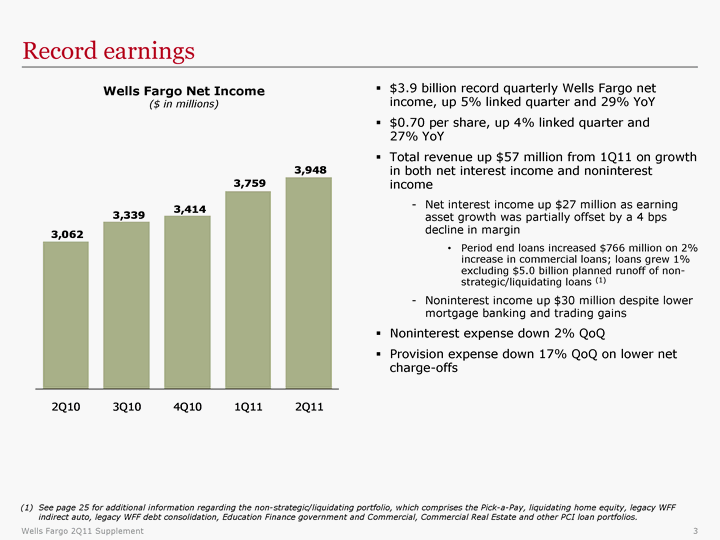
| Record earnings $3.9 billion record quarterly Wells Fargo net income, up 5% linked quarter and 29% YoY $0.70 per share, up 4% linked quarter and 27% YoY Total revenue up $57 million from 1Q11 on growth in both net interest income and noninterest income Net interest income up $27 million as earning asset growth was partially offset by a 4 bps decline in margin Period end loans increased $766 million on 2% increase in commercial loans; loans grew 1% excluding $5.0 billion planned runoff of non- strategic/liquidating loans (1) Noninterest income up $30 million despite lower mortgage banking and trading gains Noninterest expense down 2% QoQ Provision expense down 17% QoQ on lower net charge-offs Wells Fargo Net Income ($ in millions) (1) See page 25 for additional information regarding the non-strategic/liquidating portfolio, which comprises the Pick-a-Pay, liquidating home equity, legacy WFF indirect auto, legacy WFF debt consolidation, Education Finance government and Commercial, Commercial Real Estate and other PCI loan portfolios. |

| Period-end loans Growth despite continued reduction in non-strategic/liquidating portfolio Loans up $766 million from 1Q11 Commercial loans up $7.5 billion, or 2%, on growth throughout our commercial portfolio driven primarily by new customer activity Consumer loans down 2% driven by non- strategic loan portfolio runoff partially offset by growth in auto, credit card and private student lending Non-strategic/liquidating loans (1) down $5.0 billion from 1Q11 Core loans grew $5.8 billion, or 1%, from 1Q11 Total average loan yield of 5.00% down 3 bps linked quarter and 34 bps YoY driven by runoff of higher yielding non-strategic loan portfolio Period-end balances. (1) See page 25 for additional information regarding the non-strategic/liquidating portfolio, which comprises the Pick-a-Pay, liquidating home equity, legacy WFF indirect auto, legacy WFF debt consolidation, Education Finance government and Commercial, Commercial Real Estate and other PCI loan portfolios. Period-end Loans Outstanding ($ in billions) 766.3 (1) 753.7 757.3 751.2 751.9 Total average loan yield |

| Deposits Strong growth and reduced average cost Average core deposits of $807.5 billion up $10.7 billion from 1Q11 and up $45.7 billion, or 6%, from 2Q10 107% of average loans Average retail core deposits up 6% annualized from 1Q11 Average checking and savings up 7% annualized from 1Q11 and up $63.4 billion, or 9%, from 2Q10 91% of average core deposits Consumer checking accounts up a net 7.0% from 2Q10 7.9% growth in California 9.2% growth in New Jersey 9.5% growth in North Carolina 11.1% growth in Florida Average deposit cost of 28 bps was down 2 bps from 1Q11 and 7 bps from 2Q10 Average Deposits and Rates ($ in billions) 812.4 Average deposit cost Average Checking and Savings ($ in billions) 840.9 850.8 |
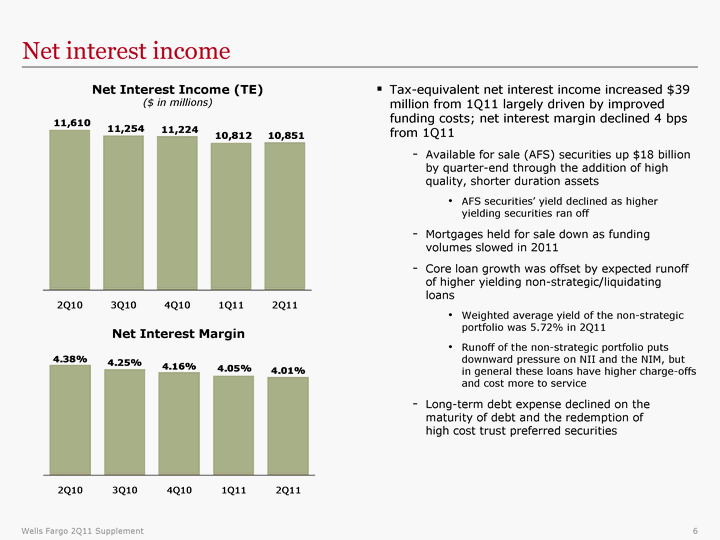
| Net interest income Net Interest Income (TE) ($ in millions) Net Interest Margin Tax-equivalent net interest income increased $39 million from 1Q11 largely driven by improved funding costs; net interest margin declined 4 bps from 1Q11 Available for sale (AFS) securities up $18 billion by quarter-end through the addition of high quality, shorter duration assets AFS securities' yield declined as higher yielding securities ran off Mortgages held for sale down as funding volumes slowed in 2011 Core loan growth was offset by expected runoff of higher yielding non-strategic/liquidating loans Weighted average yield of the non-strategic portfolio was 5.72% in 2Q11 Runoff of the non-strategic portfolio puts downward pressure on NII and the NIM, but in general these loans have higher charge-offs and cost more to service Long-term debt expense declined on the maturity of debt and the redemption of high cost trust preferred securities |

| Noninterest income Noninterest income up $30 million linked quarter and down 2% YoY Service charges on deposit account fees up 6% from 1Q11 on customer account growth and seasonal increases in consumer spending, and down 24% from 2Q10 reflecting impact of Reg E Card fees up 5% linked quarter (LQ) and up 10% YoY on higher volumes and new account growth Mortgage banking down 20% LQ and 19% from 2Q10 on lower originations and lower gain on sale margins Insurance up 13% LQ primarily due to seasonally higher crop insurance Trading gains down 32% LQ reflecting lower customer-based sales volumes Equity gains up $371 million LQ primarily arising from our equity investment businesses |

| Noninterest expense Noninterest expense was down $258 million from 1Q11 driven by lower commissions and incentive compensation, employee benefits and equipment expense; down $865 million from 4Q10 Salaries increased $130 million, or 4%, on March annual merit increases and increased day count in the quarter $484 million of integration costs in 2Q11, up $44 million from 1Q11 on increased integration activity 64% of merger integration costs in the quarter were from outside professional services, contract services and advertising Other expense included $428 million in operating losses substantially all from litigation accruals for mortgage foreclosure- related matters |

| Expense discipline and initiatives Expense management is a longstanding part of the Wells Fargo culture and operating model Project Compass is a company-wide initiative aimed at removing unnecessary complexity and eliminating duplication as a way to improve the customer experience and team member work processes In June 2010, the EVP of Enterprise Expense Management was named to lead the initiative Undertaken thoughtfully to help ensure revenue is not adversely affected during the process of eliminating certain expenses Using a "bottom-up" approach, at a very granular level across the organization Over 1,000 team members throughout the company have been involved Areas of focus have been identified, sized and have entered the implementation phase such that we are already starting to see some of the benefits Progress reports provided monthly to the Company's Management Committee Structured to ensure there is no impact on merger integration activities Savings realized are intended to reach the bottom line, however, reinvesting in the business remains a priority |

| Areas of focus Research phase of Project Compass has identified several areas of opportunity to become more efficient, broadly grouped as follows: 1) Staff/Technology functions - consists of two components: re-engineering staff functions and IT consistency Re-engineering staff functions - removing unnecessary complexity and eliminating duplication Centralizing transactional activities and expert functions, standardizing delivery models of services, streamlining approval processes, reducing customization, and eliminating work altogether Supplying team members with more self-service tools IT consistency - eliminating inefficiencies and reducing variability by simplifying the technology environment across the company Realigning infrastructure (e.g., data centers and LANs), support activities (e.g., help desks), data environments and application development and support We recently moved technology support for HR, Finance, Corporate Properties and Internet Services under the Corporate Technology group to enhance risk management and focus IT skills rather than fragment them 2) Loan resolution/loss mitigation/foreclosed asset expense - while expenses should moderate as the credit cycle improves, process improvements will be made as well Automating asset tracking and payment processing Renegotiating and standardizing contracts enterprise-wide for collections and systems Implementing alternative customer contact solutions, e.g., online and mobile Centralizing/consolidating functions |

| Areas of focus (continued) |
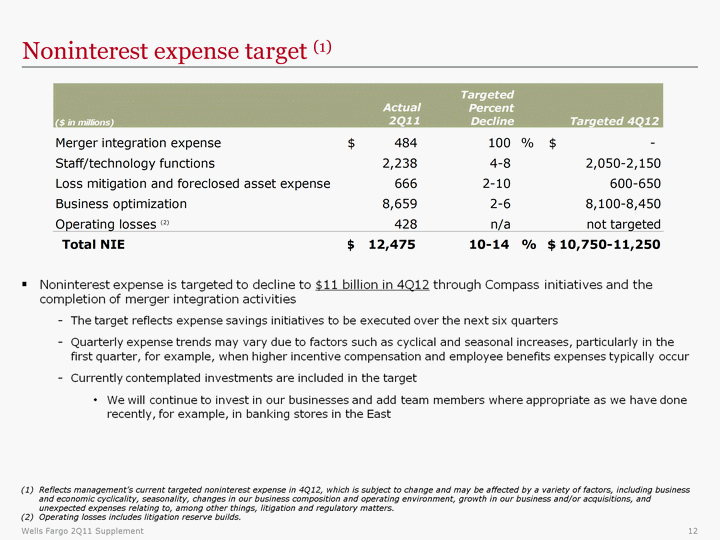
| Noninterest expense target (1) (1) Reflects management's current targeted noninterest expense in 4Q12, which is subject to change and may be affected by a variety of factors, including business and economic cyclicality, seasonality, changes in our business composition and operating environment, growth in our business and/or acquisitions, and unexpected expenses relating to, among other things, litigation and regulatory matters. (2) Operating losses includes litigation reserve builds. |

| Community Banking Lower segment earnings reflects lower mortgage banking revenues Average loans declined 2% despite growth in auto, credit card, private student lending and SBA lending Regional Banking Strong combined net checking gains Consumer checking up a net 7.0% from 2Q10 Business checking up a net 4.5% from 2Q10 Combined retail bank household cross-sell of 5.84 products per household up from 5.64 in 2Q10 West cross-sell = 6.25 East cross-sell = 5.29 Core product solutions of 8.33 million in the West, up 16% from 2Q10 Wells Fargo Home Mortgage Mortgage originations down $20 billion from 1Q11 while application volumes were up 7% Managed residential mortgage servicing flat from 2Q10 = $1.8 trillion (1) Checking account growth is period-ending, 12-month rolling. (2) Western footprint including Wells Fargo and Wachovia customers. |

| Wholesale Banking Net interest income up 8% from 1Q11 on strong loan and investment securities growth Average loans up 4%, or 14% linked quarter annualized (LQA), driven primarily by new customer activity Noninterest income down 2% QoQ as lower sales and trading results were partially offset by solid investment banking results, seasonally higher insurance fees and higher PCI related gains Net charge-offs were down 16 bps QoQ to 33 bps Expenses down 1% QoQ on lower personnel expense Treasury Management Commercial card spend volume of $3.17 billion up 10% QoQ Investment Banking U.S. investment banking market share 2011 YTD (2) of 4.7% up from 4.2% in FY2010 Asset Management Total AUM up 6% and mutual funds AUM up 2% YoY (1) Approved and initiated. (2) Source: Dealogic U.S. investment banking fee market share. |

| Wealth, Brokerage and Retirement Net interest income down 1% from 1Q11 due to lower yields Average loans up 2% QoQ and YoY on growth in Wealth consumer loans and brokerage lines of credit and margin loans Average core deposits stable QoQ and up 4% YoY Noninterest income down 2% from 1Q11 driven by a decline in retail brokerage transaction revenues partially offset by an increase in asset- based fees Brokerage managed account assets up 3% QoQ and 31% YoY; fees are priced at the beginning of the quarter, reflecting 3/31/2011 market valuations Expenses down 3% QoQ on lower personnel expenses Announced sale of H.D. Vest Financial Services Retail Brokerage Increase in managed account assets, up 31% YoY, driven by strong net flows and market gains Wealth Management Wealth Management client assets up 8% YoY Retirement IRA assets up 16% YoY Institutional Retirement plan assets up 18% YoY (1) Includes deposits. (2) Data as of May 2011. |

| Wachovia merger update Merger integration nearing successful completion 83% of all banking customers on a single platform after the Pennsylvania and Florida conversions 2,215 store conversions completed through July 9, 2011 23.7 million accounts converted including mortgage, deposits, trust, brokerage and credit cards Remaining Eastern banking markets scheduled to convert by year end 875 Wachovia stores left to be rebranded as Wells Fargo Growth opportunities already being realized due to merger revenue synergies: Community Banking Consumer checking account sales up in the Eastern retail banking stores over 30% from a year ago Credit card penetration in converted markets of 14.5%, up from 13.2% at year end 2010 Core indirect auto loans up over 50% since the merger Wholesale Banking Investment Banking market share of 4.7% YTD up from 3.7% YTD 2009 (1) Foreign Exchange revenue from Wholesale customers up 24% YTD compared to 2010 2Q11 trade fees from corporate and commercial customers up 13% LQA Wealth, Brokerage and Retirement Client assets in WBR up 27% since merger Net flows into managed accounts of more than $50 billion realized since merger Loans originated through brokers up 47% since merger (1) Source: Dealogic U.S. investment banking fee market share. |

| Credit quality Continued decline in provision expense $2.8 billion net charge-offs, down $372 million from 1Q11 and 48% from 4Q09 peak Provision expense of $1.8 billion, down $372 million from 1Q11, includes a $1.0 billion reserve release in line with 1Q11 Allowance for credit losses = $21.3 billion Remaining PCI nonaccretable = 29.7% of remaining UPB (1) Credit metrics showed continued improvement $2.6 billion QoQ decline in NPAs reflects $1.9 billion decline in nonaccrual loans on lower inflows and $651 million decline in foreclosed assets Early stage delinquencies, both balances and rates, declined QoQ (0.50) (0.65) (0.85) Reserve Release 3.99 3.45 2.99 5.33 5.91 6.11 5.09 (1) Unpaid principal balance for PCI loans that have not had a UPB charge-off. Provision Expense ($ in billions) 2.21 (1.0) 1.84 (1.0) |
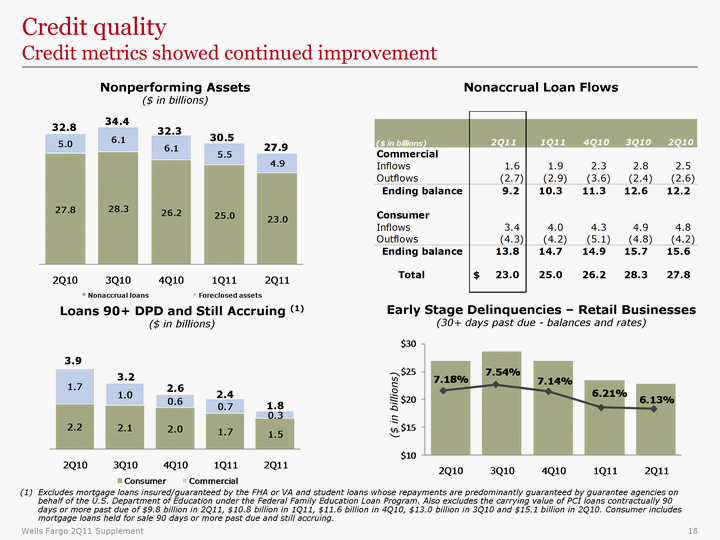
| Credit quality Credit metrics showed continued improvement Nonperforming Assets ($ in billions) 2.6 3.2 3.9 Early Stage Delinquencies - Retail Businesses (30+ days past due - balances and rates) Nonaccrual Loan Flows 32.3 34.4 32.8 30.5 2.4 Loans 90+ DPD and Still Accruing (1) ($ in billions) Excludes mortgage loans insured/guaranteed by the FHA or VA and student loans whose repayments are predominantly guaranteed by guarantee agencies on behalf of the U.S. Department of Education under the Federal Family Education Loan Program. Also excludes the carrying value of PCI loans contractually 90 days or more past due of $9.8 billion in 2Q11, $10.8 billion in 1Q11, $11.6 billion in 4Q10, $13.0 billion in 3Q10 and $15.1 billion in 2Q10. Consumer includes mortgage loans held for sale 90 days or more past due and still accruing. ($ in billions) 27.9 1.8 |

| Mortgage servicing Wells Fargo has a high quality servicing portfolio Residential Mortgage Servicing Portfolio $1.8 Trillion (as of June 30, 2011) Agency Retained and acquired portfolio Non-agency securitizations of WFC originated loans Non-agency acquired servicing and private whole loan sales 69% of the portfolio is with the Agencies (FNMA, FHLMC, and GNMA) 19% are loans that we retained or acquired Loss exposure handled through loan loss reserves and PCI nonaccretable 6% are private securitizations where Wells Fargo originated the loan and therefore has some repurchase risk 80% prime at origination 58% from pre-2006 vintages Insignificant amount of home equity and no option ARMs ~50% do not have traditional reps and warranties 6% are non-agency acquired servicing and private whole loan sales 4% is acquired servicing where Wells Fargo did not underwrite and securitize and has repurchase recourse with the originator 2% are private whole loan sales Less than 3% subprime at origination Loans sold to others and subsequently securitized are included in private securitizations above |

| Mortgage servicing Delinquency ratios favorable to peers and total repurchase demands down As of 1Q11, the delinquency and foreclosure ratio of Wells Fargo's servicing portfolio continued to be lower than peers, per industry data Wells Fargo's total delinquency and foreclosure ratio for 2Q11 was 7.44%, down from a peak of 8.96% in 4Q09 Increase from 1Q11 primarily driven by an uptick in the percent in foreclosure as timelines for foreclosure have extended Total repurchase demands down (both number and balances) for the fourth consecutive quarter, and losses down to $261 million from $331 million in 1Q11 Agency Total agency repurchase demands outstanding up from 1Q11 due to an acceleration of timing of demand requests, which can fluctuate Demands and losses continued to be concentrated in the 2006 - early 2008 vintages Non-Agency Non-agency repurchase demands outstanding, which includes non-agency securities, whole loans sold and acquired servicing, down for the third consecutive quarter 1Q11 Servicing Portfolio Delinquency Performance (1) (Data as of March 31, 2011) (1) Inside Mortgage Finance. (2) Industry is all large servicers ($7.1 trillion) including WFC, C, JPM and BAC. (3) Includes mortgage insurance rescissions. (2) Total Outstanding Repurchase Demands (3) and Agency New Demands for 2006-2008 Vintages Count Original Balance ($ in B) |
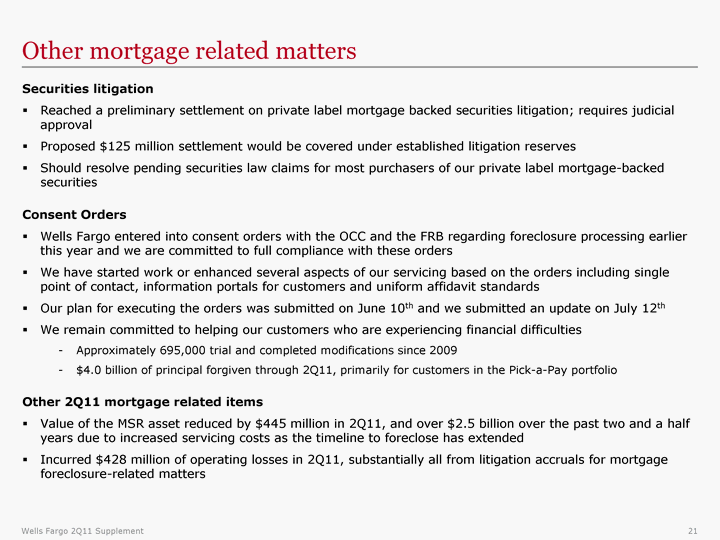
| Other mortgage related matters Securities litigation Reached a preliminary settlement on private label mortgage backed securities litigation; requires judicial approval Proposed $125 million settlement would be covered under established litigation reserves Should resolve pending securities law claims for most purchasers of our private label mortgage-backed securities Consent Orders Wells Fargo entered into consent orders with the OCC and the FRB regarding foreclosure processing earlier this year and we are committed to full compliance with these orders We have started work or enhanced several aspects of our servicing based on the orders including single point of contact, information portals for customers and uniform affidavit standards Our plan for executing the orders was submitted on June 10th and we submitted an update on July 12th We remain committed to helping our customers who are experiencing financial difficulties Approximately 695,000 trial and completed modifications since 2009 $4.0 billion of principal forgiven through 2Q11, primarily for customers in the Pick-a-Pay portfolio Other 2Q11 mortgage related items Value of the MSR asset reduced by $445 million in 2Q11, and over $2.5 billion over the past two and a half years due to increased servicing costs as the timeline to foreclose has extended Incurred $428 million of operating losses in 2Q11, substantially all from litigation accruals for mortgage foreclosure-related matters |

| Capital Capital remained strong and continued to grow internally Tier 1 common +23 bps in 2Q11 Other capital ratios growing Tier 1 Capital = 11.7% Tier 1 Leverage = 9.4% Tier 1 common equity ratio under Basel III is estimated to be 7.4% at 6/30/11 (1) $3.4 billion of high-cost trust preferred securities redeemed in 2Q11 Weighted average coupon of 7.44% Redemptions funded through internal sources Repurchased 35 million common shares in the quarter See Appendix page 50 for additional information on Tier 1 common equity. 2Q11 capital ratios are preliminary estimates. (1) Pro forma calculation based on Tier 1 common equity, as adjusted to reflect management's interpretation of current Basel III capital proposals. This pro forma calculation is subject to change depending on final promulgation of Basel III capital rulemaking and interpretations thereof by regulatory authorities. See page 51 for additional information. Tier 1 Common Equity Ratio |

| Summary Record earnings Strong returns with highest ROA in 3 years Linked quarter revenue growth Period-end loan growth driven by commercial loans Deposit growth reflects strong account growth Noninterest expense down with additional opportunities for further reduction - targeting 4Q12 noninterest expense of $11 billion Continued improvement in credit quality Capital levels continued to grow |

| Appendix |

| (1) Effective 1Q11, we included our education finance government guaranteed loan portfolio as there is no longer a U.S. Government guaranteed student loan program available to private financial institutions, pursuant to legislation in 2010. Prior periods have been adjusted to reflect this change. (2) Net of purchase accounting adjustments. -$27.6 -$8.2 -$8.2 Non-strategic/liquidating loan portfolio (1) risk reduction -$7.1 -$6.5 -$6.4 -$5.0 -$69.0 |

| 23 bps increase in Tier 1 common equity ratio in 2Q11 High quality capital stack 78% of Tier 1 Capital is Tier 1 Common, up from 72% in 2Q10 77% of total assets are risk-weighted assets, down from 79% in 2Q10 (1) June 30, 2011, capital ratios are preliminary. (2) See table on page 50 for more information on Tier 1 Common Equity. Capital strength |
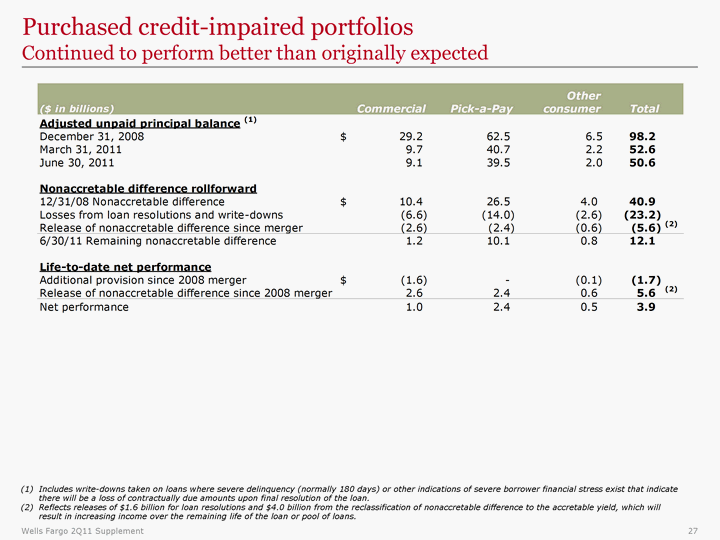
| Purchased credit-impaired portfolios Continued to perform better than originally expected (1) Includes write-downs taken on loans where severe delinquency (normally 180 days) or other indications of severe borrower financial stress exist that indicate there will be a loss of contractually due amounts upon final resolution of the loan. (2) Reflects releases of $1.6 billion for loan resolutions and $4.0 billion from the reclassification of nonaccretable difference to the accretable yield, which will result in increasing income over the remaining life of the loan or pool of loans. |

| (1) Release of the nonaccretable difference for settlement with borrower, on individually accounted PCI loans, increases interest income in the period of settlement. Pick-a-Pay and Other consumer PCI loans do not reflect nonaccretable difference releases due to pool accounting for those loans, which assumes that the amount received approximates the pool performance expectations. (2) Release of the nonaccretable difference as a result of sales to third parties increases noninterest income in the period of the sale. (3) Reclassification of nonaccretable difference to accretable yield for loans with increased cash flow estimates will result in increased interest income as a prospective yield adjustment over the remaining life of the loan or pool of loans. (4) Write-downs to net realizable value of PCI loans are absorbed by the nonaccretable difference when severe delinquency (normally 180 days) or other indications of severe borrower financial stress exist that indicate there will be a loss of contractually due amounts upon final resolution of the loan. $43 million nonaccretable difference released in 2Q11 into income due to loan resolutions $36 million in net interest income; $7 million in noninterest income $95 million reclassified to accretable yield in 2Q11 $12.1 billion in nonaccretable difference remains to absorb losses on PCI loans Nonaccretable difference established in purchase accounting for PCI loans absorbs losses otherwise recorded as charge-offs Purchased credit-impaired (PCI) loan portfolio update Nonaccretable difference in 2Q11 |

| Purchased credit-impaired (PCI) portfolio Available nonaccretable difference Includes write-downs taken on loans where severe delinquency (normally 180 days) or other indications of severe borrower financial stress exist that indicate there will be a loss of contractually due amounts upon final resolution of the loan. |

| PCI accretable yield 2Q11 results included accretion of $587 million compared with $701 million in 1Q11 1Q11 results included a large gain from the sale of a significant portion of a pool of non Pick-a-Pay consumer real estate 1-4 family first mortgage loans Balance of $14.9 billion expected to accrete to income over the remaining life of the underlying loans Expected cash flows on all PCI portfolios are recalculated quarterly including the adequacy of life-of-loan loss marks (nonaccretable difference) 2Q11 changes in expected cash flows primarily driven by the Pick-a-Pay portfolio Lifetime expected cash flows are updated quarterly and can fluctuate based on estimates and assumptions Cash flows estimates can be affected by changes in interest rates, liquidation timing, the pace of the economic and housing recovery and loan modification activity While projected accretion declined this quarter, the PCI cash flows are still significantly better than estimated at acquisition (1) Includes accretable yield released as a result of settlements with borrowers, which is included in interest income. (2) Includes accretable yield released as a result of sales to third parties, which is included in noninterest income. (3) Represents changes in cash flows expected to be collected due to changes in interest rates on variable rate PCI loans, changes in prepayment assumptions and the impact of modifications. |
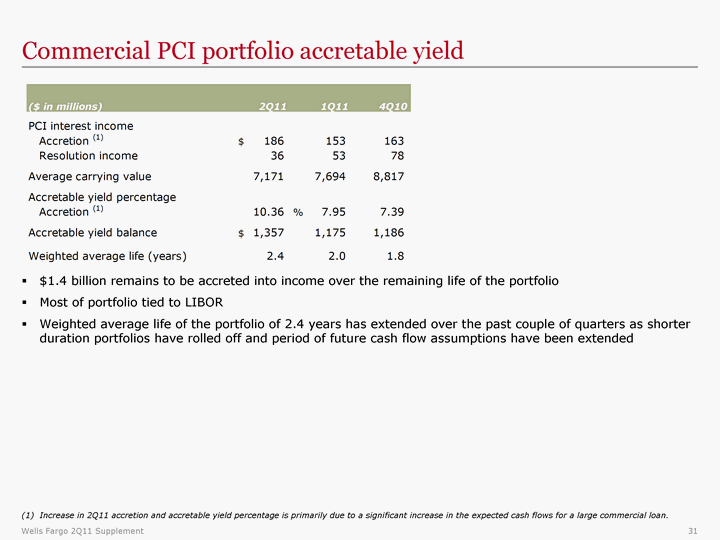
| $1.4 billion remains to be accreted into income over the remaining life of the portfolio Most of portfolio tied to LIBOR Weighted average life of the portfolio of 2.4 years has extended over the past couple of quarters as shorter duration portfolios have rolled off and period of future cash flow assumptions have been extended Commercial PCI portfolio accretable yield (1) Increase in 2Q11 accretion and accretable yield percentage is primarily due to a significant increase in the expected cash flows for a large commercial loan. |
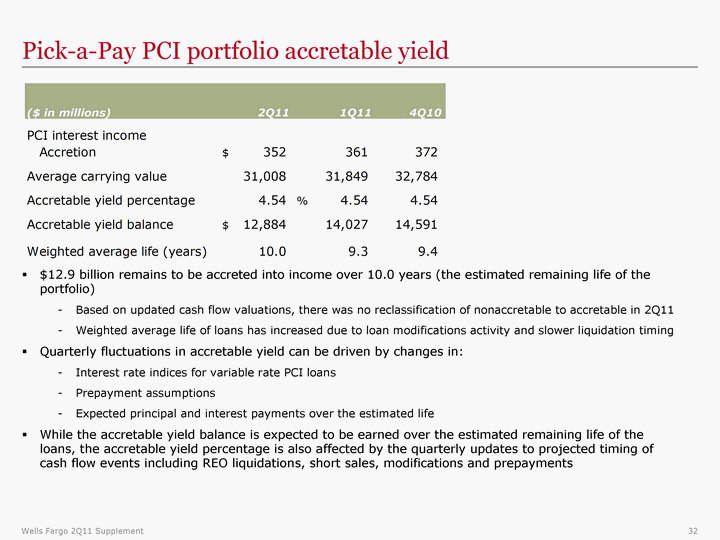
| $12.9 billion remains to be accreted into income over 10.0 years (the estimated remaining life of the portfolio) Based on updated cash flow valuations, there was no reclassification of nonaccretable to accretable in 2Q11 Weighted average life of loans has increased due to loan modifications activity and slower liquidation timing Quarterly fluctuations in accretable yield can be driven by changes in: Interest rate indices for variable rate PCI loans Prepayment assumptions Expected principal and interest payments over the estimated life While the accretable yield balance is expected to be earned over the estimated remaining life of the loans, the accretable yield percentage is also affected by the quarterly updates to projected timing of cash flow events including REO liquidations, short sales, modifications and prepayments Pick-a-Pay PCI portfolio accretable yield |

| 2Q11 Credit quality highlights Allowance for credit losses $21.3 billion 1.87x annualized quarterly charge-offs 2.83% of total loans $12.1 billion in nonaccretable difference for PCI portfolio in addition to allowance Provision expense declined $372 million and was $1.0 billion less than net charge-offs in the quarter Net charge-offs of $2.8 billion down $372 million from 1Q11 with declines across all loan categories except for foreign and real estate 1-4 family 1st mortgage Commercial losses declined $121 million Consumer losses down $251 million Currently expect future reserve releases absent significant deterioration in the economy |

| Nonperforming assets Commercial nonaccruals of $9.2 billion 95% secured and approximately 64% guaranteed Over 56% are currently paying interest that is applied to principal $2.4 billion in losses taken to date Consumer nonaccruals of $13.8 billion > 99% secured 36% CLTV (1) below 80% $4.0 billion in losses taken to date Partial write-downs have been recognized on 52% of ending balances $15.7 billion of troubled debt restructurings (TDRs), including $3.8 billion of nonaccrual TDRs, have $4.2 billion of loan impairment for expected life-of-loan loss reserves Foreclosed assets down $651 million 57% of the balance are government guaranteed loans and loans written down through purchase accounting $1.3 billion, or 27%, are government guaranteed $1.5 billion, or 30%, reflects shift from PCI loans to REO ($469 million consumer and $993 million commercial and CRE) Remaining balance represents real estate loans (residential and CRE) and have already been written down The current loan-to-value (CLTV) ratio is calculated as the outstanding loan balance divided by the collateral value. The table above does not include PCI loans that were contractually 90 days past due and still accruing. Also excludes real estate 1-4 family mortgage loans whose repayments are insured by the Federal Housing Administration or guaranteed by the Department of Veterans Affairs and student loans predominantly guaranteed by agencies on behalf of the U.S. Department of Education under the Federal Family Education Loan Program. |
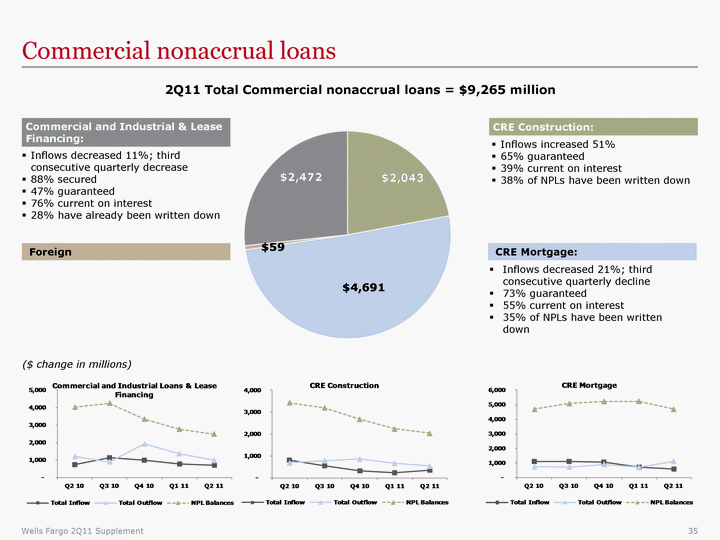
| Commercial nonaccrual loans 2Q11 Total Commercial nonaccrual loans = $9,265 million ($ change in millions) Commercial and Industrial & Lease Financing: CRE Construction: CRE Mortgage: Foreign Inflows decreased 11%; third consecutive quarterly decrease 88% secured 47% guaranteed 76% current on interest 28% have already been written down Inflows increased 51% 65% guaranteed 39% current on interest 38% of NPLs have been written down Inflows decreased 21%; third consecutive quarterly decline 73% guaranteed 55% current on interest 35% of NPLs have been written down |

| Consumer real estate nonaccrual loans Inflows increased 1% Outflows increased 2% 48% are 1-4 family first mortgage 24% are TDRs for which impairment has been recognized 75% is legacy WFF debt consolidation Inflows decreased 27% Outflows decreased 16% 45% written down; losses taken stable from prior quarter 12% is WBR Inflows decreased 22%; third consecutive quarterly decline 48% written down; losses taken stable from prior quarter 60% are > 180 DPD Inflows declined 14% Outflows declined 4% 85% of NPLs held at current estimated recoverable value 23% are TDRs for which impairment has been recognized See page 43 for additional information 2Q11 Total residential real estate nonaccrual loans = $13,525 million Inflows continued to decline while outflows slowed reflecting environment and seasonality All comparisons are to 1Q11. (1) Includes National Home Equity first and junior lines and loans. (2) Total inflows and outflows tracked on left scale and RE NPL balances tracked on right scale. National Home Equity (1): Home Mortgage: Pick-a-Pay: Other Businesses: ($ change in millions) (2) |

| Commercial real estate (CRE) loan portfolio Office Industrial, Warehouse Other RE Apartment Retail (Ex Shopping Ctr) Land (Ex 1-4 Family) Shopping Ctr Hotel/Motel 1-4 Family Land Institutional Other CA FL TX NC GA NY VA AZ WA CO Other Reduction in outstandings reflects paydowns in the construction portfolio 31% of the portfolio is owner-occupied CRE loans by property type CRE loans by geography Agriculture |
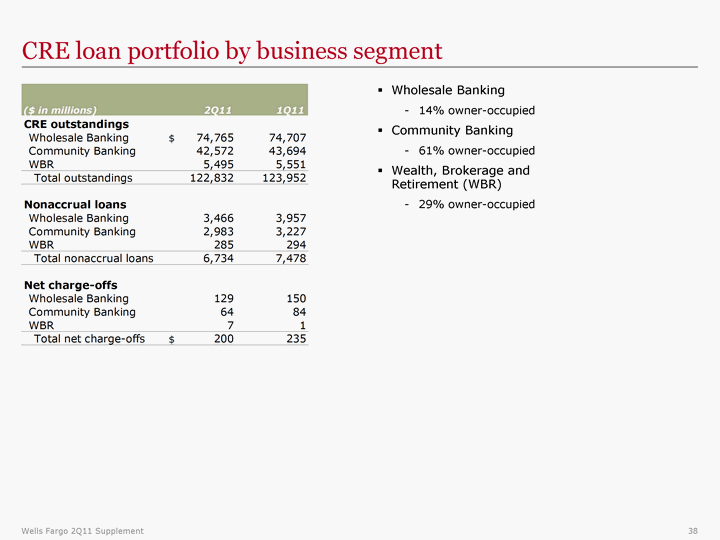
| CRE loan portfolio by business segment Wholesale Banking 14% owner-occupied Community Banking 61% owner-occupied Wealth, Brokerage and Retirement (WBR) 29% owner-occupied |
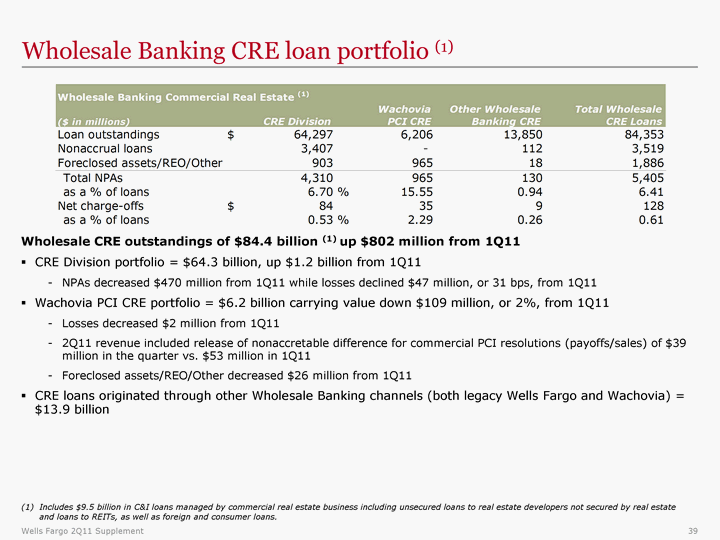
| Wholesale Banking CRE loan portfolio (1) Wholesale CRE outstandings of $84.4 billion (1) up $802 million from 1Q11 CRE Division portfolio = $64.3 billion, up $1.2 billion from 1Q11 NPAs decreased $470 million from 1Q11 while losses declined $47 million, or 31 bps, from 1Q11 Wachovia PCI CRE portfolio = $6.2 billion carrying value down $109 million, or 2%, from 1Q11 Losses decreased $2 million from 1Q11 2Q11 revenue included release of nonaccretable difference for commercial PCI resolutions (payoffs/sales) of $39 million in the quarter vs. $53 million in 1Q11 Foreclosed assets/REO/Other decreased $26 million from 1Q11 CRE loans originated through other Wholesale Banking channels (both legacy Wells Fargo and Wachovia) = $13.9 billion Includes $9.5 billion in C&I loans managed by commercial real estate business including unsecured loans to real estate developers not secured by real estate and loans to REITs, as well as foreign and consumer loans. |

| Pick-a-Pay mortgage portfolio Carrying value of $69.6 billion in first lien loans outstanding, down $1.9 billion from 1Q11 and down $25.7 billion from 4Q08 on paid-in-full loans and loss mitigation efforts Adjusted unpaid principal balance of $78.2 billion, down $2.4 billion from 1Q11 and down $37.5 billion from 4Q08 $4.0 billion in modification principal forgiveness since acquisition reflects over 90,000 completed full-term modifications Pick-a-Pay loans with negative amortization potential decreased $2.8 billion from 1Q11 to 56% of loans Total portfolio deferred interest of $2.3 billion down $171 million from 1Q11 and down $2.0 billion from 4Q08; down for ninth consecutive quarter Expect minimal recast risk over next 3 years due to product structure and features Approximately $11 million, or 54 loans, expected in the rest of 2011, approximately $66 million, or 273 loans, expected in 2012 and approximately $289 million or 991 loans in 2013 Modification redefault rate has been consistently better than the industry average (as measured by 60+ DPD after 6 months) as we have strived to give customers an affordable, sustainable payment Adjusted unpaid principal includes write-downs taken on loans where severe delinquency (normally 180 days) or other indications of severe borrower financial stress exist that indicate there will be a loss of contractually due amounts upon final resolution of the loan. |
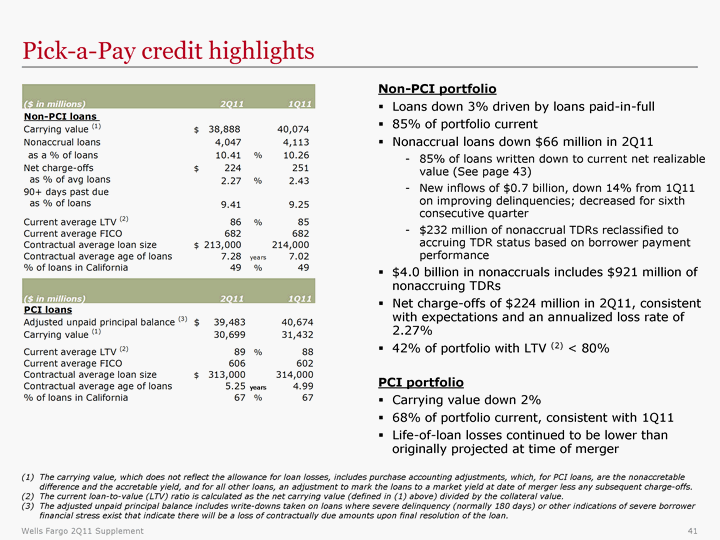
| Pick-a-Pay credit highlights Non-PCI portfolio Loans down 3% driven by loans paid-in-full 85% of portfolio current Nonaccrual loans down $66 million in 2Q11 85% of loans written down to current net realizable value (See page 43) New inflows of $0.7 billion, down 14% from 1Q11 on improving delinquencies; decreased for sixth consecutive quarter $232 million of nonaccrual TDRs reclassified to accruing TDR status based on borrower payment performance $4.0 billion in nonaccruals includes $921 million of nonaccruing TDRs Net charge-offs of $224 million in 2Q11, consistent with expectations and an annualized loss rate of 2.27% 42% of portfolio with LTV (2) < 80% PCI portfolio Carrying value down 2% 68% of portfolio current, consistent with 1Q11 Life-of-loan losses continued to be lower than originally projected at time of merger The carrying value, which does not reflect the allowance for loan losses, includes purchase accounting adjustments, which, for PCI loans, are the nonaccretable difference and the accretable yield, and for all other loans, an adjustment to mark the loans to a market yield at date of merger less any subsequent charge-offs. (2) The current loan-to-value (LTV) ratio is calculated as the net carrying value (defined in (1) above) divided by the collateral value. (3) The adjusted unpaid principal balance includes write-downs taken on loans where severe delinquency (normally 180 days) or other indications of severe borrower financial stress exist that indicate there will be a loss of contractually due amounts upon final resolution of the loan. |
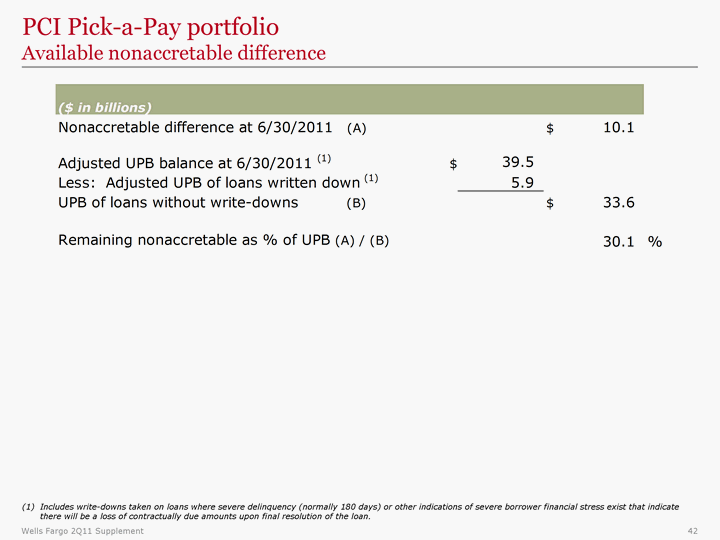
| PCI Pick-a-Pay portfolio Available nonaccretable difference Includes write-downs taken on loans where severe delinquency (normally 180 days) or other indications of severe borrower financial stress exist that indicate there will be a loss of contractually due amounts upon final resolution of the loan. |

| Pick-a-Pay nonaccrual loan composition (1) 85% of Pick-a-Pay nonaccruals held at estimated recoverable value vs. 83% at 1Q11, reflecting write-downs and/or LTV ^100% Allowance available for the remaining 15% that have not yet been written down 8% of the nonaccruals are performing modifications Performing modifications move to accruing status after six consecutive payments are made 6/30/11 Total $4,047 million Charge-offs to date of $705 million (29% of original balance) No charge-offs to date 63% of loans have LTV<80% 35% of loans have LTV^80% but <100% 2% of loans have LTV^100% (2) Initial charge-offs usually not taken until 180 DPD ($38 million taken to date) Expected losses included in allowance Charge-offs/principal forgiveness to date of $216 million (19% of original balance) Additionally, we hold expected life- of-loan loss reserves in allowance LTV is considered to be over 100% if the loan balance exceeds current estimated appraised value based on automated valuation methodology or updated appraisal where available. Calculation excludes unpaid principal balance of related equity lines of credit that share common collateral. (1) Does not include PCI Pick-a-Pay since they are considered to be accruing under PCI loan accounting for accretable yield and accrual status is not based on contractual interest payments. (2) Loans with LTV>100% are currently in modification trial periods. 180 DPD written down to estimated recoverable value 0-179 DPD Loan modifications (TDRs) 180 DPD updated LTV ^ 100% |

| Real estate 1-4 family first mortgage portfolio First lien mortgage loans down reflecting declines in runoff portfolios Pick-a-Pay non-PCI portfolio down 3% PCI portfolio down 2% Debt consolidation down 3% Non runoff first lien down 1% Core first lien mortgage nonaccruals down $441 million, or 30 bps Non runoff net charge-offs up $42 million, or 12 bps (1) Ratios on WFF debt consolidation loan portfolio only. (2) Ratios on non runoff first lien mortgage loan portfolio only. |

| Home equity portfolio (1) Core Portfolio (2) Outstandings down 3% High quality new originations with weighted average CLTV of 61%, 777 FICO, and 32% total debt service ratio 2Q11 losses down $116 million, or 36 bps 2+ delinquencies declined $174 million, or 7 bps Continued decline in delinquency rate for loans with a CLTV >100%, 29 bps improvement QoQ Liquidating Portfolio Outstandings down 5% 2Q11 losses down $20 million, or 88 bps 2+ delinquencies declined $25 million, or 17 bps Continued decline in delinquency rate for loans with a CLTV >100%, 32 bps improvement QoQ (1) Excludes purchased credit-impaired loans. (2) Includes equity lines of credit and closed-end junior liens associated with the Pick-a-Pay portfolio totaling $1.6 billion at June 30, 2011, and $1.6 billion at March 31, 2011. (3) CLTV quarter-end based predominantly on estimated home values from automated valuation models updated through June 2011. Total loans include all open-to-buy and unused lines of credit. |

| $110.7 billion home equity portfolio (1) 19% in 1st lien position 41% in junior lien position behind WFC owned or serviced 1st lien 40% in junior lien position behind third party 1st lien (1) Excludes purchased credit-impaired loans. (2) Delinquency represents two or more payments past due as of May 2011. Home equity portfolio (1) |

| Credit card portfolio $21.2 billion credit card outstandings up 1% from 1Q11 on new customer activity Less than 3% of total Wells Fargo loans Net charge-offs down $88 million, or 158 bps, reflecting previous risk mitigation efforts that included tightened underwriting and line management changes (i.e. lower volumes of balance transfer offers and tightened criteria for credit line increases) |

| Auto portfolio Core Portfolio Total outstandings up 3% QoQ and up 10% YoY reflecting continued strong loan originations Originations were down 3% from 1Q11 and up 12% from 2Q10 Net charge-offs declined $44 million, or 47 bps, on low delinquencies and continued strength in used car values June Manheim index of 127.5, up 3% from March 2011 and up 6% from June 2010 30+ days past due increased $111 million, or 92 bps, reflecting previous quarters' loan growth and seasonality Liquidating Portfolio (2) Legacy Wells Fargo Financial indirect auto outstandings down 21%, or $1.1 billion, QoQ driven by paydowns Reflects transfer of loans from direct to indirect portfolio in 1Q11. Legacy Wells Fargo Indirect portfolio. |
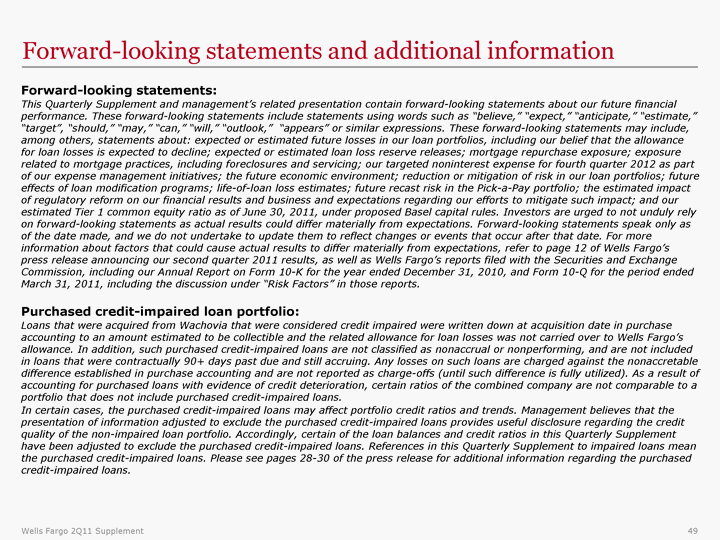
| Forward-looking statements and additional information Forward-looking statements: This Quarterly Supplement and management's related presentation contain forward-looking statements about our future financial performance. These forward-looking statements include statements using words such as "believe," "expect," "anticipate," "estimate," "target", "should," "may," "can," "will," "outlook," "appears" or similar expressions. These forward-looking statements may include, among others, statements about: expected or estimated future losses in our loan portfolios, including our belief that the allowance for loan losses is expected to decline; expected or estimated loan loss reserve releases; mortgage repurchase exposure; exposure related to mortgage practices, including foreclosures and servicing; our targeted noninterest expense for fourth quarter 2012 as part of our expense management initiatives; the future economic environment; reduction or mitigation of risk in our loan portfolios; future effects of loan modification programs; life-of-loan loss estimates; future recast risk in the Pick-a-Pay portfolio; the estimated impact of regulatory reform on our financial results and business and expectations regarding our efforts to mitigate such impact; and our estimated Tier 1 common equity ratio as of June 30, 2011, under proposed Basel capital rules. Investors are urged to not unduly rely on forward-looking statements as actual results could differ materially from expectations. Forward-looking statements speak only as of the date made, and we do not undertake to update them to reflect changes or events that occur after that date. For more information about factors that could cause actual results to differ materially from expectations, refer to page 12 of Wells Fargo's press release announcing our second quarter 2011 results, as well as Wells Fargo's reports filed with the Securities and Exchange Commission, including our Annual Report on Form 10-K for the year ended December 31, 2010, and Form 10-Q for the period ended March 31, 2011, including the discussion under "Risk Factors" in those reports. Purchased credit-impaired loan portfolio: Loans that were acquired from Wachovia that were considered credit impaired were written down at acquisition date in purchase accounting to an amount estimated to be collectible and the related allowance for loan losses was not carried over to Wells Fargo's allowance. In addition, such purchased credit-impaired loans are not classified as nonaccrual or nonperforming, and are not included in loans that were contractually 90+ days past due and still accruing. Any losses on such loans are charged against the nonaccretable difference established in purchase accounting and are not reported as charge-offs (until such difference is fully utilized). As a result of accounting for purchased loans with evidence of credit deterioration, certain ratios of the combined company are not comparable to a portfolio that does not include purchased credit-impaired loans. In certain cases, the purchased credit-impaired loans may affect portfolio credit ratios and trends. Management believes that the presentation of information adjusted to exclude the purchased credit-impaired loans provides useful disclosure regarding the credit quality of the non-impaired loan portfolio. Accordingly, certain of the loan balances and credit ratios in this Quarterly Supplement have been adjusted to exclude the purchased credit-impaired loans. References in this Quarterly Supplement to impaired loans mean the purchased credit-impaired loans. Please see pages 28-30 of the press release for additional information regarding the purchased credit-impaired loans. |

| Tier 1 common equity under Basel I (1) |

| Tier 1 common equity under Basel III (Estimated) (1) |
